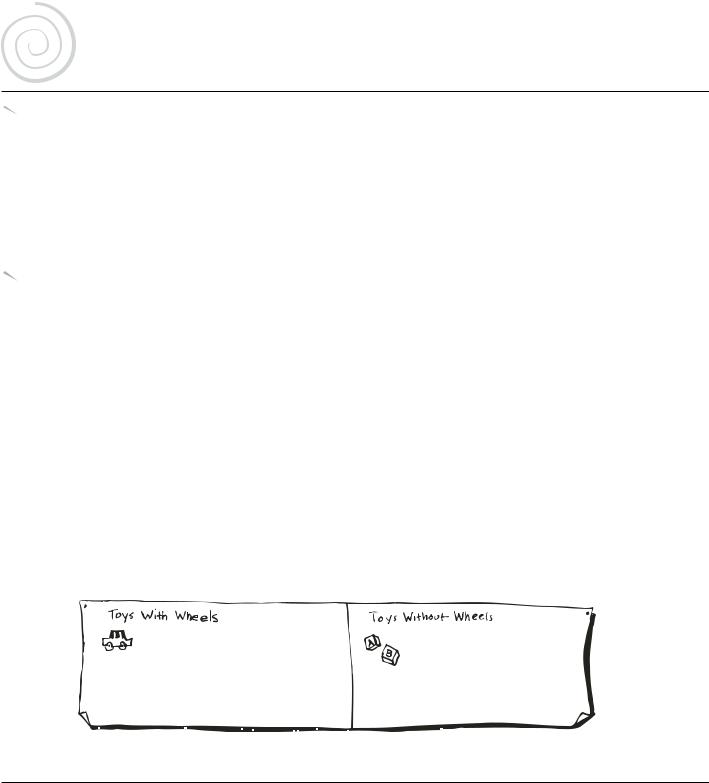
- •Table of Contents
- •Early Childhood
- •Introduction
- •Name Game
- •Up and Down
- •On the Outside
- •Rainbow Dolls
- •Responsible Me
- •The Mirror and Me
- •Positive Statements Poster
- •Talking Tube
- •The Circle of Noise
- •Happy Hands, Sad Hands
- •Feeling Faces
- •Knock, Knock
- •Friendship Ring
- •Language and Literacy
- •Wonder Why
- •What If?
- •How Many Ways?
- •Rhyming Riddles
- •Story Bag
- •Symbol Stories
- •Answers and Questions
- •Simon Says Opposites
- •Fun with Books
- •Nonverbal Communication
- •Words All Around Us
- •Alphabet Letter Magnets
- •Listen to the Sound
- •Math
- •Counting Song
- •Counting Catches
- •Number Match Game
- •Seasonal Number Rhyme
- •How Many?
- •Walk Around the Shape
- •Shapes in the Air
- •I Spy a Shape
- •Shape Bingo
- •Shape Dance
- •What Does It Weigh?
- •Lengthy Fun
- •Shape Patterns
- •Patterns in Sound
- •Science
- •People, Places, and Things
- •Same and Different
- •Bug in the Rug Game
- •Backwards Photos
- •Nature Walk Stories
- •Shadow Explorations
- •Buzz
- •The Fan Club
- •When We Were Small
- •What Is the Weather?
- •Time for Graphing
- •Sink or Float?
- •Qualities
- •Light Show
- •Music and Movement
- •Drumbeats Movement
- •Streamer Fun
- •Musical Instruments
- •Music Everywhere
- •High and Low
- •Music Detectives
- •Partners Move!
- •Moving with Scarves
- •Dance Fever
- •Visual Arts
- •Musical Collage
- •Puzzle Mural
- •Playdough Creation
- •Our Sculpture
- •Brick Building Mural
- •Sculpture Bags
- •Sticky Mural
- •Weaving Net
- •Chalk Pizza
- •Dramatic Play
- •Nursery Rhyme Fun
- •Space Adventure
- •Airplane Trip
- •Fly In and Out the Window
- •Pumpkin Patch
- •Row Your Boat
- •Mousy Moves
- •Sticky Story
- •Animals Sleeping
- •Football Practice
- •Motor Skills
- •Build a Tower
- •The Feather Dance
- •Fun with a Parachute
- •Beanbag Game
- •Hoops of Fun
- •Wading Pool Fun
- •Bubble Wrap Play
- •Dot-to-Dot Mural
- •The Friendship Squeeze
- •Musical Chairs and More
- •Moving with Carpet Squares
- •Walk the Line
- •Copycat

Math
44 SHAPE PATTERNS
 Materials
Materials
Felt
Scissors
Flannelboard
 Activity
Activity
Cut squares and circles out of several different colors of felt. Give each child and yourself an identical set of felt shapes. Use your felt shapes to make a pattern on a flannelboard. Have the children use their shapes to repeat your pattern. Name the pattern together. Make a new pattern with your shapes. As you are putting the shapes on the flannelboard, ask the children to predict which color and shape will come next. Once the children have copied several of your patterns, let them try making their own patterns.
45 PATTERNS IN SOUND
 Materials
Materials
None
 Activity
Activity
Talk about the many different sounds the children can make with their voices and bodies. Let each child demonstrate a different sound, such as clapping, stomping, tapping, clicking, laughing, or whispering. Tell the children that you would like to take their sounds and use them to make a pattern. Choose two sounds, such as clapping and stomping. Have everyone join you as you clap, stomp, clap, stomp. Then let the children think up other sound patterns to make.
Variation: Sing the following song. Let the children choose which actions they would like to do. Substitute the names of those actions for stomp, jump, and clap.
Sung to: “Frere Jacques”
Stomp-jump-clap, stomp-jump-clap.
Stomp-jump-clap, stomp-jump-clap.
Stomp-jump and clap,
Stomp-jump and clap.
Stomp-jump-clap, stomp-jump-clap.
Gayle Bittinger
© School Specialty Publishing |
38 |
1-57029-486-0 101 Circle Time Activities |

CHAPTER 4
Science
46 PEOPLE, PLACES, AND THINGS
 Materials
Materials
Magazines
Scissors
Manila envelopes
Poster board
Index cards
Glue
 Activity
Activity
Recognizing similarities and differences and classifying are important science skills. This activity will help young children develop both of these skills. Look through magazines to collect a variety of interesting pictures. As you collect the pictures, categorize them according to topic. Manila envelopes work well for this purpose. You might start with five or six categories, such as people, transportation, animals, plants, houses, and toys. Look for pictures of all sizes. Glue large pictures onto pieces of poster board and smaller ones onto index cards.
Once you have collected a number of pictures in each category, use them to explore similarities and differences with the children. For example, show the children eight or ten dog pictures. Have them think of ways the dogs are the same and ways the dogs are different. Let them decide on how to categorize the dogs—by size, by color, by type, by whether or not it is wearing a collar, or by some other criteria. Repeat with other sets of pictures. Encourage the children to think of a wide range of ways to sort each group. For example, they could sort pictures of people by age, facial expression, or whether they are sitting or standing. They could sort pictures of houses by color, by size, by number of windows, or by whether or not they have a chimney.
© School Specialty Publishing |
39 |
1-57029-486-0 101 Circle Time Activities |

Science
47 SAME AND DIFFERENT
 Materials
Materials
Familiar objects
 Activity
Activity
Help the children develop their observational skills with this activity. Have the children sit in a circle and place five or six familiar objects (a block, a rubber ball, a key, a clothespin, and a crayon) in the middle. Ask the children to compare and contrast the items. Encourage them to notice the size, shape, material, and color of each object. Let them think of something each object has in common (they are all found in our room, they are all useful, etc.) and a way in which they are all different (each one is a different size, each one is a different color, etc.).
Hint: When doing this activity with younger children, you may need to ask specific questions about the objects’ characteristics. For example, you could ask the children to tell you which object is yellow, which one you write with, or which one is small.
48 BUG IN THE RUG GAME
 Materials
Materials
Large blanket
 Activity
Activity
Play this game to develop children’s observation skills. Spread a large blanket out on the floor and have the children sit around the edges of it. Ask one child to step away from the group and turn around. Choose another child to be the “bug” that hides under the blanket “rug.” Ask the first child to rejoin the group. Sing the following song. At the end of the song, pause and let the child name the “bug under the rug.”
Sung to: “Eensy, Weensy Spider”
There’s a little bug
Who is hiding in this rug.
Will you play this game
And try to guess its name?
Do you know the bug
Who is hiding in the rug?
Yes, I do. Yes, it’s true.
The bug’s name is ________.
© School Specialty Publishing |
40 |
1-57029-486-0 101 Circle Time Activities |

Science
49 BACKWARDS PHOTOS
 Materials
Materials
Sheet
Camera with film
 Activity
Activity
This activity develops children’s observational and deductive reasoning skills. To prepare, you will need to take a photograph of the back of each child. To make the pictures look consistent, hang a sheet in the corner of your room. One at a time, have the children stand in front of the sheet with their backs to you. Take a picture of each child’s back, then have the photos developed. Invite the children to sit in a circle. Hold up one of the photos. Have the children guess whose back is showing in the picture. Encourage them to observe the details in the photograph. Ask them to think about who has hair like that. Who wears clothes like that? Help them put all the information together to guess whose back is in the photo. When the children guess correctly, hang the photo on a bulletin board. Continue until all the children have been identified.
50 NATURE WALK STORIES
 Materials
Materials
Art materials
 Activity
Activity
Sharing ideas in a variety of ways is one thing that scientists do. This activity encourages the children to think about three different ways to communicate a group experience. Take the children on an outdoor nature walk. After the walk, have the children sit in a circle and remember what they saw on the walk. Let each child decide how he or she would like to share a story about the walk with the group—by dictating a story, drawing a picture, or acting out something they saw. Set out art materials (construction paper, markers, scissors, glue, etc.) for the children who would prefer to draw a picture of the walk. Have pencil and paper ready for those who would like to dictate a story. Let the children who would like to act out something practice in a separate area. When all the children are finished, have them sit in a circle. Let each child share his or her own nature walk story through the retelling of a dictated story, showing a picture, or acting out a scene. Encourage the children to ask one another questions.
Variation: Try this activity to communicate any kind of story or information, such as “How to Care for a Pet,” “What We Did at School Today,” or “My Family.”
© School Specialty Publishing |
41 |
1-57029-486-0 101 Circle Time Activities |
